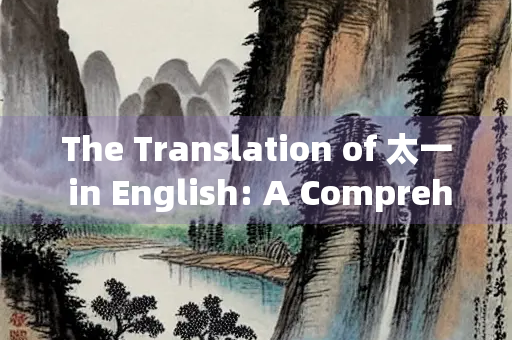Introduction

The term "太一" (Tài Yī) holds significant cultural, philosophical, and historical weight in Chinese tradition. Translating it into English poses challenges due to its multifaceted meanings across different contexts, including Daoism, ancient cosmology, and mythology. This article delves into the possible translations of "太一," examining its origins, interpretations, and the most accurate English equivalents.
Etymology and Meaning of "太一"
"太一" is composed of two Chinese characters:
太 (Tài): Meaning "great," "supreme," or "ultimate."
一 (Yī): Meaning "one," "unity," or "the first."
Together, "太一" conveys the id ea of the "Supreme One," "Great Unity," or "Ultimate Oneness." It represents a primordial, all-encompassing force in Chinese philosophy and religion.
Historical and Philosophical Contexts
1. Daoist Philosophy
In Daoism, "太一" is closely associated with the concept of theDao (道), the fundamental principle underlying the universe. It signifies the origin of all existence, the undifferentiated source from which everything emerges. Some scholars translate "太一" as"The Great One" or"Supreme Unity" in this context.
2. Ancient Chinese Cosmology
In early Chinese cosmology, "太一" referred to theNorth Star (Polaris), considered the celestial pivot around which the heavens revolved. This astronomical association led to translations such as"The Great Monad" or"The Supreme Ultimate."
3. Mythological and Religious Interpretations
In Chinese mythology, "太一" was worshipped as a high deity, sometimes equated with theJade Emperor or other supreme gods. In religious texts, it has been rendered as"The Supreme Deity" or"The Primordial Unity."
Possible English Translations of "太一"
Given its diverse app lications, no single English term perfectly captures "太一." However, the following translations are commonly used depending on the context:
1、"The Great One" – Emphasi zi ng its supreme and singular nature.
2、"Supreme Unity" – Highlighting its philosophical aspect of oneness.
3、"The Supreme Ultimate" – Used in cosmological and metaphysical discussions.
4、"The Primordial One" – Reflecting its role as the origin of existence.
5、"The Great Monad" – A more esoteric translation, linking it to Neoplatonism.
Challenges in Translation
Translating "太一" is complicated because:
Cultural Nuances: Western philosophy lacks an exact equivalent for this concept.
Context Dependency: Its meaning shifts between Daoist, cosmological, and religious texts.
Linguistic Differences: Chinese characters often carry layered meanings that are difficult to convey in English.
Conclusion
The translation of "太一" into English depends heavily on the context in which it is used. Whether rendered as"The Great One," "Supreme Unity," or"The Supreme Ultimate," each interpretation captures a different facet of this profound concept. Understanding its philosophical depth and cultural significance is essential for an accurate and meaningful translation.
Ultimately, "太一" remains a term that transcends simple linguistic conversion, embodying the essence of Chinese thought on the cosmos, divinity, and existence itself.
本文地址: https://www.shuiwy.com/a/101426.html
文章来源:im
版权声明:除非特别标注,否则均为本站原创文章,转载时请以链接形式注明文章出处。
2025-12-16im
2025-12-16im
2025-12-16im
2025-12-16im
2025-12-16im
2025-12-16im
2025-12-16im
2025-12-16im
2025-12-16im
2025-12-16im
2024-03-03im
2024-01-24im
2023-05-29im
2023-06-04im
2023-06-16im
2023-10-07im
2023-06-20im
2023-10-07im
2023-06-19im
2023-06-14im
2025-01-16im
2025-04-17im
2023-09-11im
2023-05-25im
2025-04-21im
2025-04-18im
2025-04-17im
2023-06-19im
2025-01-19im
2025-04-18im
扫码二维码
获取最新动态
